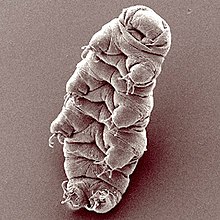Tardigrades
| Tardigrade Temporal range: Cambrian–Recent |
|
|---|---|
 |
|
| Hypsibius dujardini | |
| Scientific classification | |
| Kingdom: | Animalia |
| (unranked): | Tactopoda |
| Phylum: |
Tardigrades Spallanzani, 1777 |
| Classes | |
Tardigrades (/ˈtɑːrdᵻˌɡreɪd/; also known as water bears or moss piglets) are water-dwelling, eight-legged, segmented micro-animals. They were first discovered by the German zoologist Johann August Ephraim Goeze in 1773. The name Tardigrada (meaning "slow stepper") was given three years later by the Italian biologist Lazzaro Spallanzani. They have been found everywhere from mountaintops to the deep sea, from tropical rain forests to the Antarctic.
Tardigrades are the most resilient animal known: they can survive extreme conditions that would be rapidly fatal to nearly all other known life forms. They can withstand temperature ranges from 1 K (−458 °F; −272 °C) (close to absolute zero) to about 420 K (300 °F; 150 °C), pressures about six times greater than those found in the deepest ocean trenches, ionizing radiation at doses hundreds of times higher than the lethal dose for a human, and the vacuum of outer space. They can go without food or water for more than 30 years, drying out to the point where they are 3% or less water, only to rehydrate, forage, and reproduce.
They are not considered extremophilic because they are not adapted to exploit these conditions. This means that their chances of dying increase the longer they are exposed to the extreme environments, whereas true extremophiles thrive in a physically or geochemically extreme environment that would harm most other organisms.
Usually, tardigrades are about 0.5 mm (0.02 in) long when they are fully grown. They are short and plump with four pairs of legs, each with four to eight claws also known as "disks". The first three pairs of legs are directed ventrolaterally and are the primary means of locomotion, while the fourth pair is directed posteriorly on the terminal segment of the trunk and is used primarily for grasping the substrate. Tardigrades are prevalent in mosses and lichens and feed on plant cells, algae, and small invertebrates. When collected, they may be viewed under a very low-power microscope, making them accessible to students and amateur scientists.
...
Wikipedia
